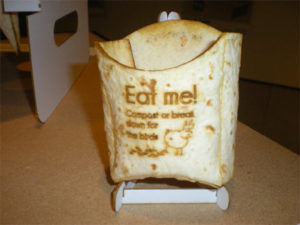Food packaging of the future: It’s edible!
by Emily Powell
While our food processing and packaging advances make the United States’ food supply one of the safest in the world, they also make it also seriously environmentally unsustainable. This is because of two (if not more) reasons: 1) the production of these materials takes energy and raw, finite materials (mostly petroleum); and 2) the plastic bags, wrappings and trays; Styrofoam cups; milk cartons; beer bottles; soda cans; and most other single-use food packaging end up in a trash can, which leads to a landfill, where they will sit for thousands (if not millions) of years without biodegrading. All in all, only 14% of plastic food packaging gets recycled. This means that the packaging “trash” that’s thrown away could be worth $11.4 billion in recycled raw materials each year. That’s a big waste of potentially valuable materials.

Now, what if we could come up with a new food packaging material that wouldn’t clog up landfills? What if it could be cheap and plentiful, like plastics, but wouldn’t need to cause the headache of recycling markets and infrastructure in order to be sustainable? Well, say hello to the coolest food packaging innovation since sliced bread (…and the plastic bag it comes in): milk protein-based, edible packaging.
A USDA research team headed by Laetitia Bonnaillie and Peggy Tomasula has released their peer-reviewed research study refining the mechanical properties of a casein protein-based, plastic-like film that can be used as an alternative to plastic food packaging. This new product is much more hydrophobic than other biodegradable, plant-based films. This means it’s better at shielding food from moisture and humidity, preserving it from bacteria and other contaminants. It’s also up to 500 times more effective at blocking oxygen than plastic films, which also makes it more suitable for food-borne illness prevention. And the best part? You can eat it.
The film is made from a protein derived from milk called casein, which makes it completely safe to consume. Although originally flavorless, the compound could be added flavors, colors, scents, or other fun things. In essence, there is future magic to be explored and future oreo wrappers to be eaten!
The tough part, unfortunately, is that the production of this material is still vastly overpriced compared to traditional petroleum-based films and packaging. This is a serious challenge when most food companies simply want food packaging to do two things: 1) draw consumers to the product, and 2) be cheap. These are the companies that see downstream waste minimization and circular economic principles as irrelevant to their business and immediate bottom line. How do we transition to a food economy that runs less on petroleum and more on drive for sustainability? It starts with us, the ever-powerful consumer constituency. So help create your ideal food environment, and make the decision to draw yourself away from single-use packaging and towards biodegradable (and edible!) packaging. And keep an eye out for the new casein-based packaging, coming to a grocer near you by 2019.
Other cool sources:
Cool YouTube video showing sciencey sustainability with edible packaging!
News from Grist: How minimizing packaging waste will save us








I just love this article. So full of information. Thanks.
This post is amazing. I just loved it. Would love to read more.